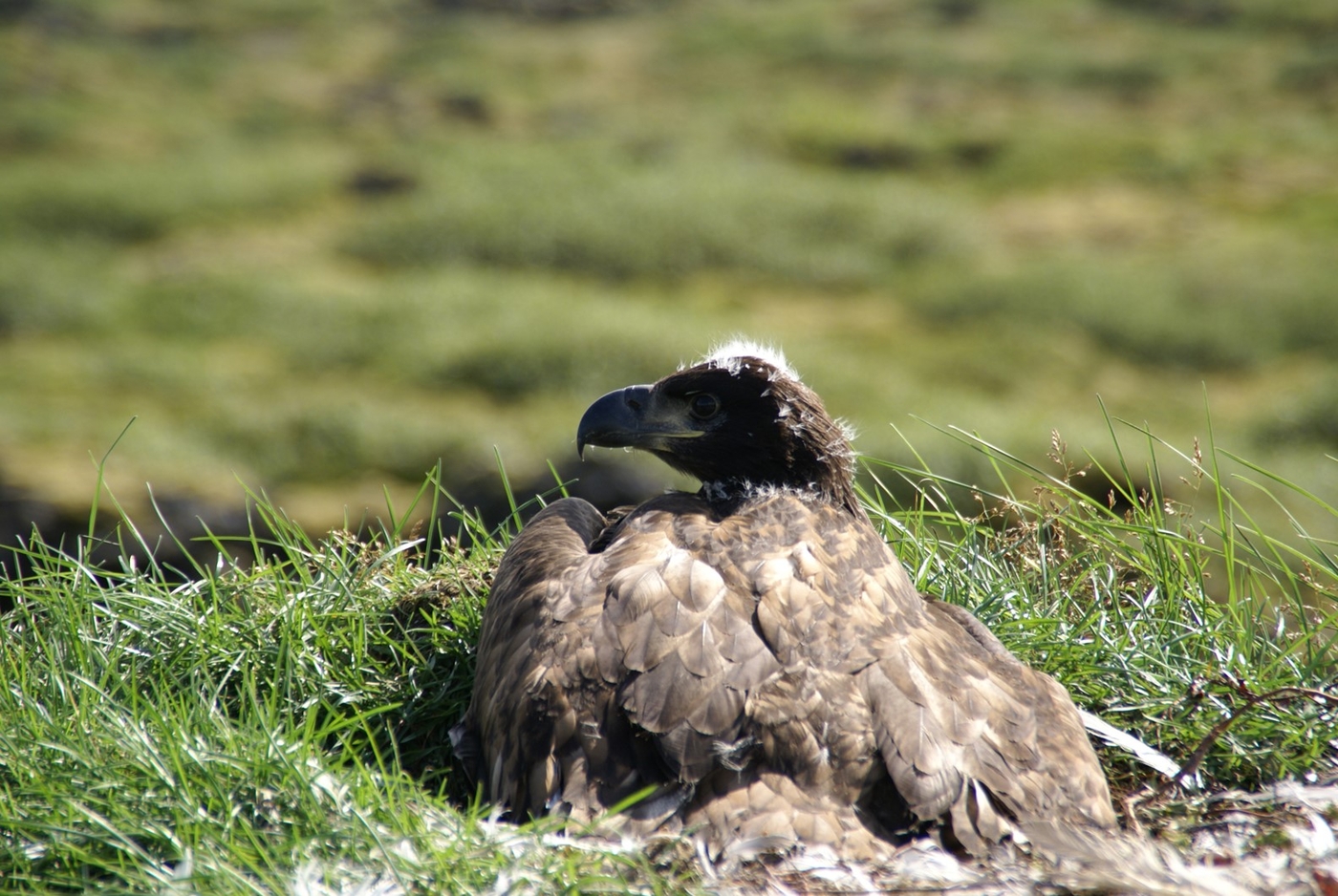Eagles are a rare sight in Iceland, and not because they soar at such extraordinary heights, but because they were almost eradicated from the Icelandic ecosystem during the 20th century. The white-tailed eagle is one of the rarest nesting birds in Iceland. There are now slightly over 100 nesting pairs, in addition to the chicks who may end up somewhere else entirely. It is also a shy bird, although it does sometimes perch for long periods on high ledges surveying its territory and searching for prey. Most eagle sightings occur when the bird is on the wing, high above its hunting ground. They are easily recognisable thanks to their enormous fingered wings and ability to soar for long periods.
White-tailed eagles are so carefully monitored in Iceland that it is safe to say that every single bird is tagged as a chick in the nest. Until the second half of the 19th century, the species was much more widespread, nesting all across the country. Today it is a different story. Now all eagle territories, a little over a hundred in total, are along the west coast. There the birds have been closely observed by scientists and officials for decades.
Fertility rates are low compared to Europe
Although the white-tailed eagle has been a protected species for over a century, the population has grown slowly, although this has improved slightly after the practice of leaving out poison for Arctic foxes was banned in 1964. White-tailed eagles are not picky eaters and will feed on carcasses, although they mainly hunt live birds, especially fulmars which they catch on the wing. They will also snatch fish from the ocean, ponds, lakes and even rivers, seeking out in particular fish that have been stranded in pools and puddles by the retreating tide. In these areas there are also a lot of other birds which are prey for the eagles.
"White-tailed eagles were almost extinct in Iceland at the start of the 20th century, due to persecution by humans and pollution, but the population has been gradually increasing in recent decades. Nevertheless, fertility rates are low compared to white-tailed eagles in mainland Europe. The average is half a chick per nesting pair per year, which is just a third of the average in Sweden."
So says Snæbjörn Pálsson, professor of population biology at the University of Iceland. Snæbjörn is currently working on diverse research related to white-tailed eagles, the largest birds of prey in Iceland.
"White-tailed eagles are magnificent birds that can help us understand the health of an ecosystem. They are tertiary consumers in the food web of coastal regions and therefore vulnerable to accumulated toxic substances, which have had a very negative effect on their fertility all over the world. By comparing genomes before and after the use of these substances, we can find out whether they have affected variations in individual genes," explains Snæbjörn.

A scientist with a passion for eagles
Although few people in Iceland have seen a white-tailed eagle in its natural environment, they are still familiar with the bird. It is a frequently photographed species and various folklore and symbolism has grown up around it.
The female is considerably larger than the male, with white-tailed eagles growing to around 5 kg with a wingspan that often exceeds 2 m. Its primary weapons are its talons, each of which is longer than the index finger of a grown man by the time the bird is just a few months old and still in the nest.
Although Snæbjörn is interested in the whole of the natural world, his research has always been primarily focused on biodiversity and how that develops. He has also explored morphological and DNA variation within species, as well as the classification of species and taxonomic diversity.
In terms of individual species, Snæbjörn has long been fascinated by white-tailed eagles and this research builds on his PhD thesis, which was about the impact of deleterious mutations in small populations.
"In small populations, natural selection is weaker than in large populations and individual mutations are more likely to be linked within chromosomes. Deleterious mutations are then more likely to accumulate. Mutations that have a beneficial effect on survival or fertility, which are much rarer, are then also less likely to become more common," says Snæbjörn.
"Analysis of a large number of genomes clearly shows inbreeding and indications of problems caused by small population size. Another PhD project is just getting started, with the aim of conducting further analysis of variations with regard to sex chromosomes, chromosome regions, genes, and differentiation within Iceland and how it links to reproductive success." image/Kristinn Ingvarsson

Blood samples taken from nestlings
Blood samples are taken from all eagle chicks that hatch in Iceland and these samples are used for a wide range of research.
"I am analysing evidence of natural selection in the eagles' genomes. In order to do that, we look at how variations are distributed by region, chromosome type, individual genes and over time," says Snæbjörn, who has spent most of his career conducting laboratory research on birds and other organisms. He has benefitted from collaboration with other biologists in collecting samples and has taken part in various research expeditions. He is therefore one of a very few people who have visited an eagle's nest.
Judging by the nesting sites, the bird has adapted its behaviour based on the way humans treat it.
It used to be extremely difficult to get to an eagle's nest. When humans were their biggest threat, the birds tended to build their nests in inaccessible spots, for example on rocky shelves high up on cliffs, to make sure that humans couldn't reach them. After the white-tailed eagle was protected, that behaviour gradually began to change. The eagles now often have several nesting sites within each territory that have been moved down from the cliffs to spits or islands, sometimes in lava fields or on hillsides. Eagle nesting sites are never publicly recorded and it is illegal to publish clues about their location or take photographs that could be used to find them.

Inbreeding and problems due to population size
Snæbjörn tells us that one doctoral thesis based on this work is already complete: a project about differentiation of populations and analysis of sex chromosomes.
"Analysis of a large number of genomes clearly shows inbreeding and indications of problems caused by small population size. Another PhD project is just getting started, with the aim of conducting further analysis of variations with regard to sex chromosomes, chromosome regions, genes, and differentiation within Iceland and how it links to reproductive success."
Snæbjörn believes that this research could certainly have a real impact on society, since it encourages people to improve the way we treat other creatures.
"The behaviour of genetic variations is interesting for research in population genetics and for the conservation of small populations. Knowledge of the impact of deleterious mutations in small natural populations is important for our understanding of evolution and conservation. The knowledge that we will gain from this research could potentially be used to protect endangered animals," says Snæbjörn.
Various connections to the UN Sustainable Development Goals
The University of Iceland is committed to advancing the UN Sustainable Development Goals through our work and research. Snæbjörn easily draws links between this research project and the SDGs.
"This research is related to Goal 15, life on land, which is about combating loss of biodiversity. It is also relevant to Goal 12, responsible consumption and production, Goal 14, life below water, and Goal 2, health and well-being."
Some people might find it a bit far-fetched to make a connection with responsible production and health and well-being. But on closer consideration, human production is one of the primary causes of pollution, which damages ecosystems, especially animals higher up the food chain. Snæbjörn also points out that healthy ecosystems are an essential part of a sustainable way of life. This is exactly what scientists are trying to achieve through this research.
"We need research like this in order to understand our world and how ecosystems work and why. We need research in order to verify our ideas. Knowledge gained through research is vital to our survival and to prevent us from destroying the lives of other animals."




